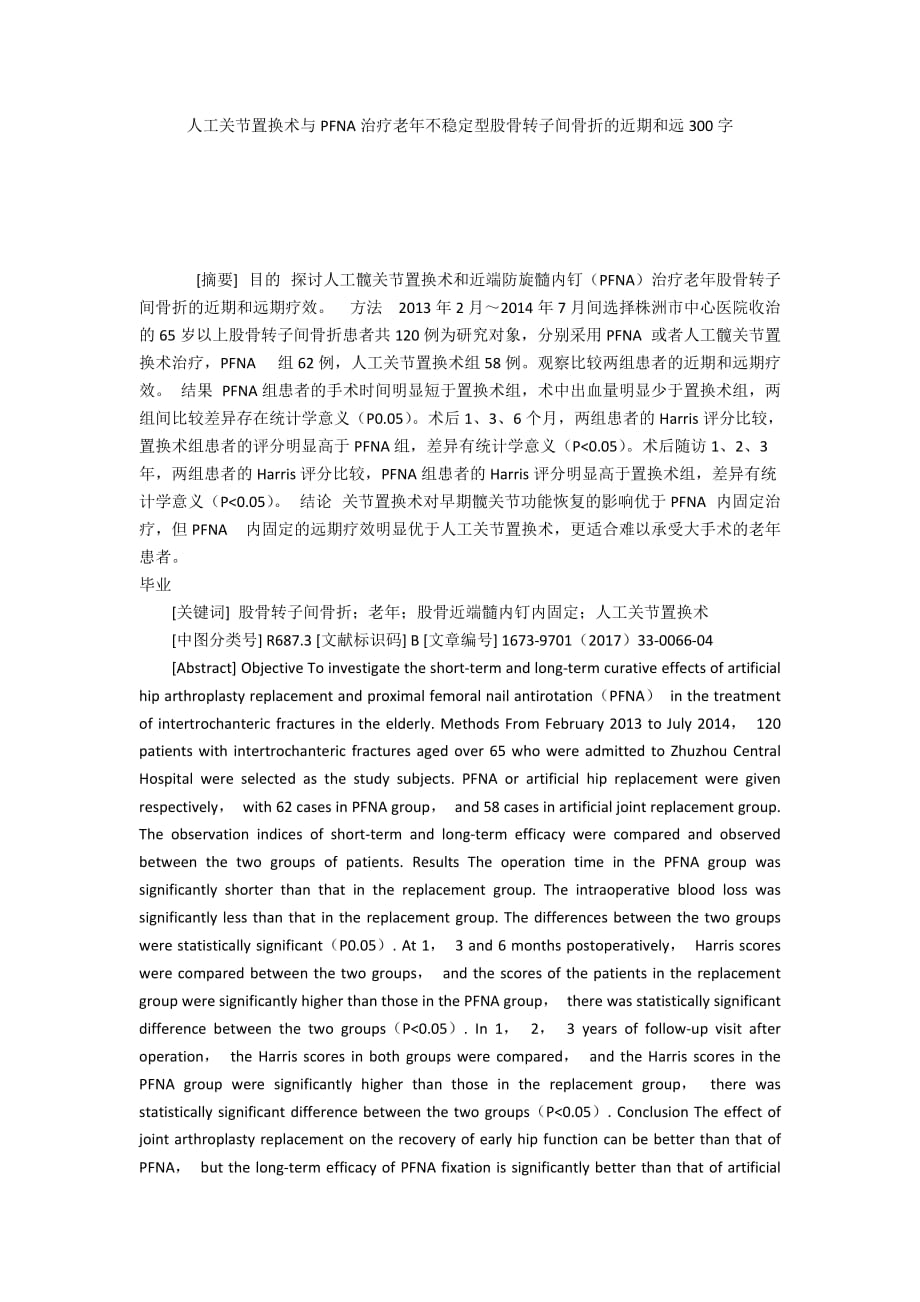《人工關(guān)節(jié)置換術(shù)與PFNA治療老年不穩(wěn)定型股骨轉(zhuǎn)子間骨折的近期和遠(yuǎn)300字》由會員分享�����,可在線閱讀,更多相關(guān)《人工關(guān)節(jié)置換術(shù)與PFNA治療老年不穩(wěn)定型股骨轉(zhuǎn)子間骨折的近期和遠(yuǎn)300字(2頁珍藏版)》請?jiān)谘b配圖網(wǎng)上搜索���。
1�����、人工關(guān)節(jié)置換術(shù)與PFNA治療老年不穩(wěn)定型股骨轉(zhuǎn)子間骨折的近期和遠(yuǎn)300字
[摘要] 目的 探討人工髖關(guān)節(jié)置換術(shù)和近端防旋髓內(nèi)釘(PFNA)治療老年股骨轉(zhuǎn)子間骨折的近期和遠(yuǎn)期療效����。 方法 2013年2月~2014年7月間選擇株洲市中心醫(yī)院收治的65歲以上股骨轉(zhuǎn)子間骨折患者共120例為研究對象���,分別采用PFNA 或者人工髖關(guān)節(jié)置換術(shù)治療��,PFNA 組62例��,人工關(guān)節(jié)置換術(shù)組58例��。觀察比較兩組患者的近期和遠(yuǎn)期療效��。 結(jié)果 PFNA組患者的手術(shù)時(shí)間明顯短于置換術(shù)組�����,術(shù)中出血量明顯少于置換術(shù)組��,兩組間比較差異存在統(tǒng)計(jì)學(xué)意義(P0.05)�����。術(shù)后1��、3����、6個(gè)月,兩組患者的
2�����、Harris評分比較��,置換術(shù)組患者的評分明顯高于PFNA組����,差異有統(tǒng)計(jì)學(xué)意義(P<0.05)���。術(shù)后隨訪1����、2、3年�����,兩組患者的Harris評分比較��,PFNA組患者的Harris評分明顯高于置換術(shù)組��,差異有統(tǒng)計(jì)學(xué)意義(P<0.05)�。 結(jié)論 關(guān)節(jié)置換術(shù)對早期髖關(guān)節(jié)功能恢復(fù)的影響優(yōu)于PFNA 內(nèi)固定治療,但PFNA 內(nèi)固定的遠(yuǎn)期療效明顯優(yōu)于人工關(guān)節(jié)置換術(shù)�����,更適合難以承受大手術(shù)的老年患者����。
畢業(yè)
[關(guān)鍵詞] 股骨轉(zhuǎn)子間骨折;老年����;股骨近端髓內(nèi)釘內(nèi)固定;人工關(guān)節(jié)置換術(shù)
[中圖分類號] R687.3 [文獻(xiàn)標(biāo)識碼] B [文章編號] 1673-9701(2017)33-0066-04
3�����、
[Abstract] Objective To investigate the short-term and long-term curative effects of artificial hip arthroplasty replacement and proximal femoral nail antirotation(PFNA) in the treatment of intertrochanteric fractures in the elderly. Methods From February 2013 to July 2014, 120 patients with inte
4���、rtrochanteric fractures aged over 65 who were admitted to Zhuzhou Central Hospital were selected as the study subjects. PFNA or artificial hip replacement were given respectively�, with 62 cases in PFNA group�����, and 58 cases in artificial joint replacement group. The observation indices of short-term a
5��、nd long-term efficacy were compared and observed between the two groups of patients. Results The operation time in the PFNA group was significantly shorter than that in the replacement group. The intraoperative blood loss was significantly less than that in the replacement group. The differences bet
6�����、ween the two groups were statistically significant(P0.05). At 1�, 3 and 6 months postoperatively, Harris scores were compared between the two groups�, and the scores of the patients in the replacement group were significantly higher than those in the PFNA group, there was statistically significant dif
7�、ference between the two groups(P<0.05). In 1���, 2�����, 3 years of follow-up visit after operation�, the Harris scores in both groups were compared, and the Harris scores in the PFNA group were significantly higher than those in the replacement group�����, there was statistically significant difference between t
8��、he two groups(P<0.05). Conclusion The effect of joint arthroplasty replacement on the recovery of early hip function can be better than that of PFNA��, but the long-term efficacy of PFNA fixation is significantly better than that of artificial joint replacement surgery�, which is more suitable to the elderly patients who are difficult to bear complicated surgical procedures.
 人工關(guān)節(jié)置換術(shù)與PFNA治療老年不穩(wěn)定型股骨轉(zhuǎn)子間骨折的近期和遠(yuǎn)300字
人工關(guān)節(jié)置換術(shù)與PFNA治療老年不穩(wěn)定型股骨轉(zhuǎn)子間骨折的近期和遠(yuǎn)300字

